Having flat feet isn’t fun. Many orthopedic problems arise when the foot’s arch isn’t raised enough. If you have flat feet, you’ll be all too familiar with the aches and pains after a day out and about. Birkenstocks know this, and they’ve spent years developing footwear solutions to give you happy feet.
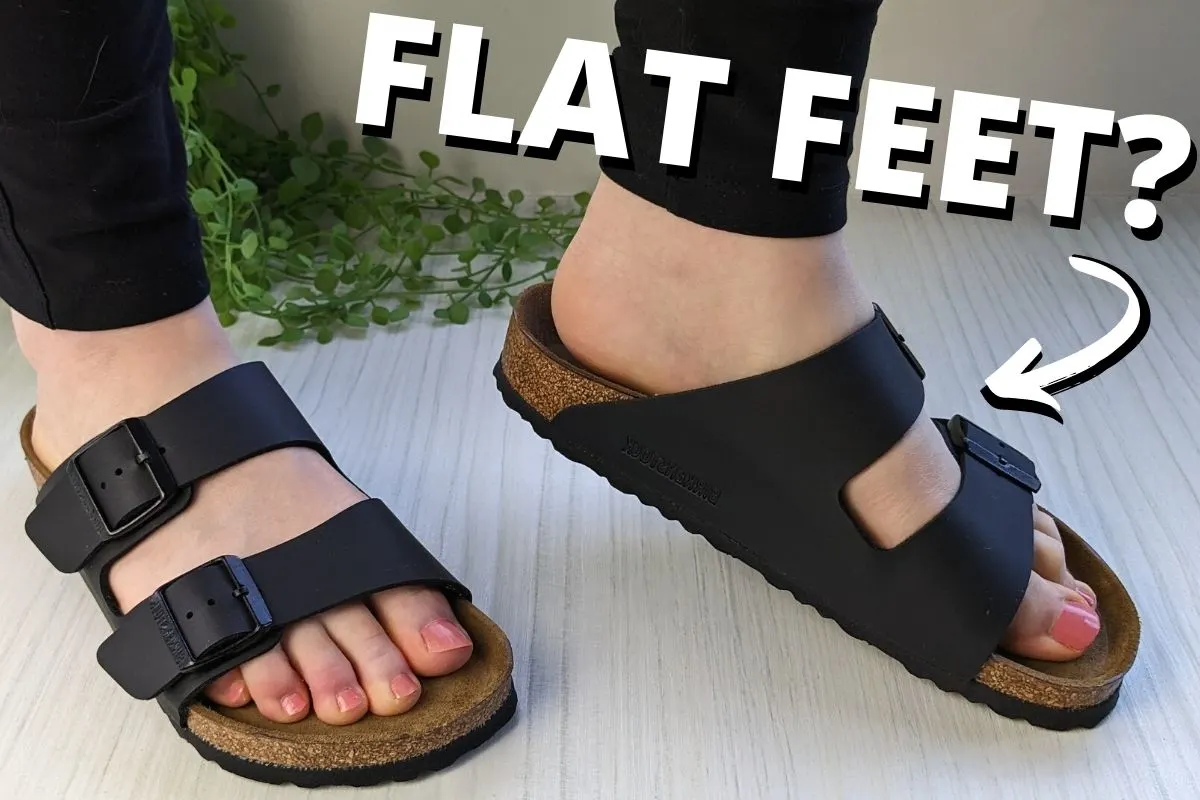
Birkenstocks are good for those with flat feet. The shoe is molded to create optimal foot positioning with an instep that is raised to keep arches from collapsing inwards and putting strain on the foot, ankles, legs, and knees. The footbed cushions the feet and provides shock absorption.
I contacted different podiatrists in my city to get their take on how suitable Birkenstocks are for flat feet.
Here is a screenshot of one of the emails and advice I received from the podiatry practices, which helped form the opinions in this article:

The takeaway advice from the above email conversation with the podiatrist was their statement: ‘as a general rule I prefer footwear that have a shaped footbed (which Birkenstocks usually do) as this gives your foot more contact with the ground.’ They also made it clear an in person assessment is your best first step.
Here’s a close up of the shaped Birkenstock footbed, so you can get a visual:
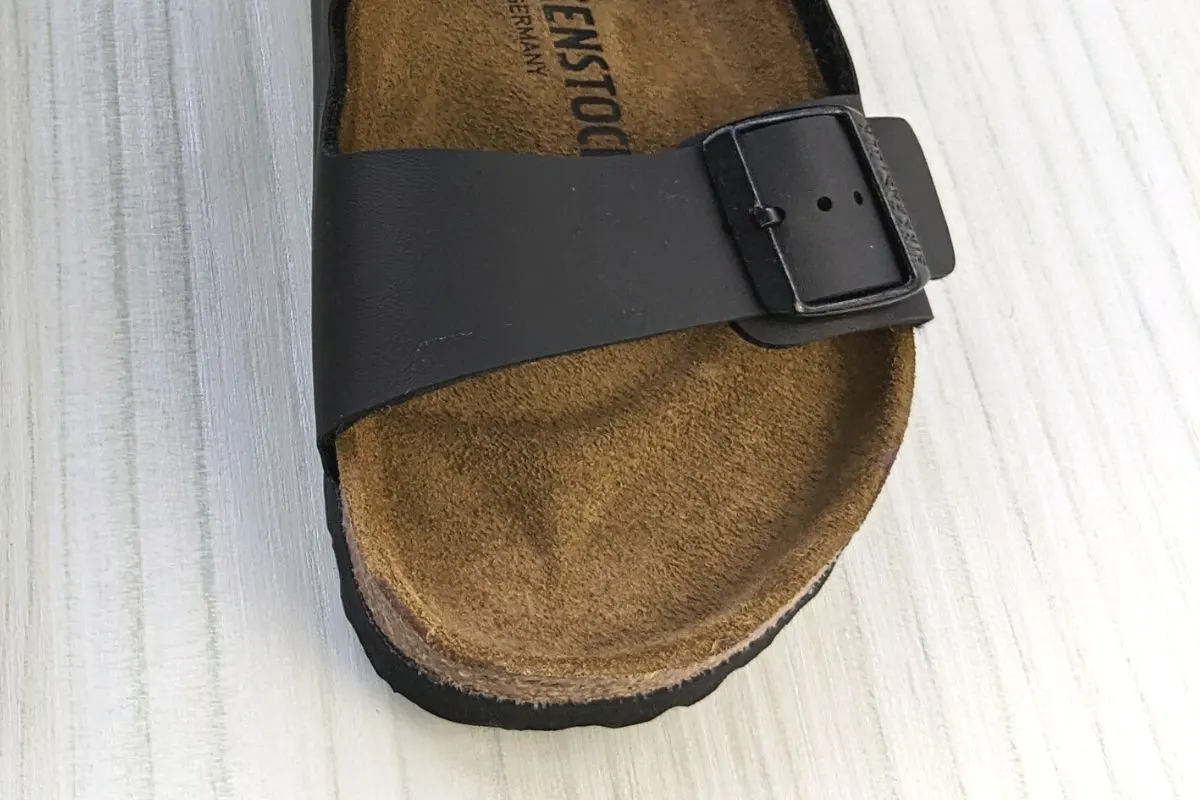
Another podiatry practice I contacted via telephone also informed me that Birkenstocks are a great option for those with flat feet, however it’s always best to have your feet assessed and to receive individual footwear recommendations in person at your local podiatry practice. Please keep this in mind before making any purchases.
To see the current price of Birkenstocks, check out their website birkenstock.com as part of your research.
You have probably heard for yourself that Birkenstocks are hailed as one of the ultimate orthopedic shoes and garnered support from healthcare professionals and fashionistas. So, what’s all the fuss about? Read on for a detailed breakdown of how Birkenstocks take corrective care of your foot troubles.
*This page may contain affiliate links. As an Amazon Associate I earn from qualifying purchases at no additional cost to you. Learn More.
Birkenstocks Provide A Solution For Flat Feet
The structure of a foot is often overlooked in the manufacturing of shoes. Feet, however, need special attention as they are the base on which your body is balanced and carry the full weight of the entire body.
One of the most common foot problems is flat feet. An underdeveloped arch has a profound and prolonged impact on your feet and all the connecting bones, tissue, muscles, and tendons. A foot without a raised arch gives reduced support to your body.
Think about this, there are 26 bones, 33 joints, and over a hundred ligaments, muscles, and tendons in a foot. All this works together to give your foot stability, movement, and range of movement. The foot does not function as it should when these are misaligned.
One of the most important orthopedic conditions that Birkenstocks address is flat feet. Each sandal or shoe provides excellent support and alignment for flat feet.
You may also like: Do Birkenstocks Run Big? Sizing Guide Plus Charts
Birkenstocks Are Crafted With Orthopedic Skill
Birkenstocks have an interesting history focusing on foot health, and they’ve been around since 1774. Named after the founder Johann Adam Birkenstock, a German shoemaker saw the need to create healthy shoes that provided contoured support for feet. At the time, shoes were made as a foot covering or foot-contorting in fashionable styles.
The initial concept of the footbed was introduced in 1896. This revolutionary footwear design at the time formed the foundation for the Birkenstock success story.
In 1973, the current, improved footbed was launched to the U.S. market. The new and improved design started making waves as not only a shoe for long workdays but also a gained a dedicated following.
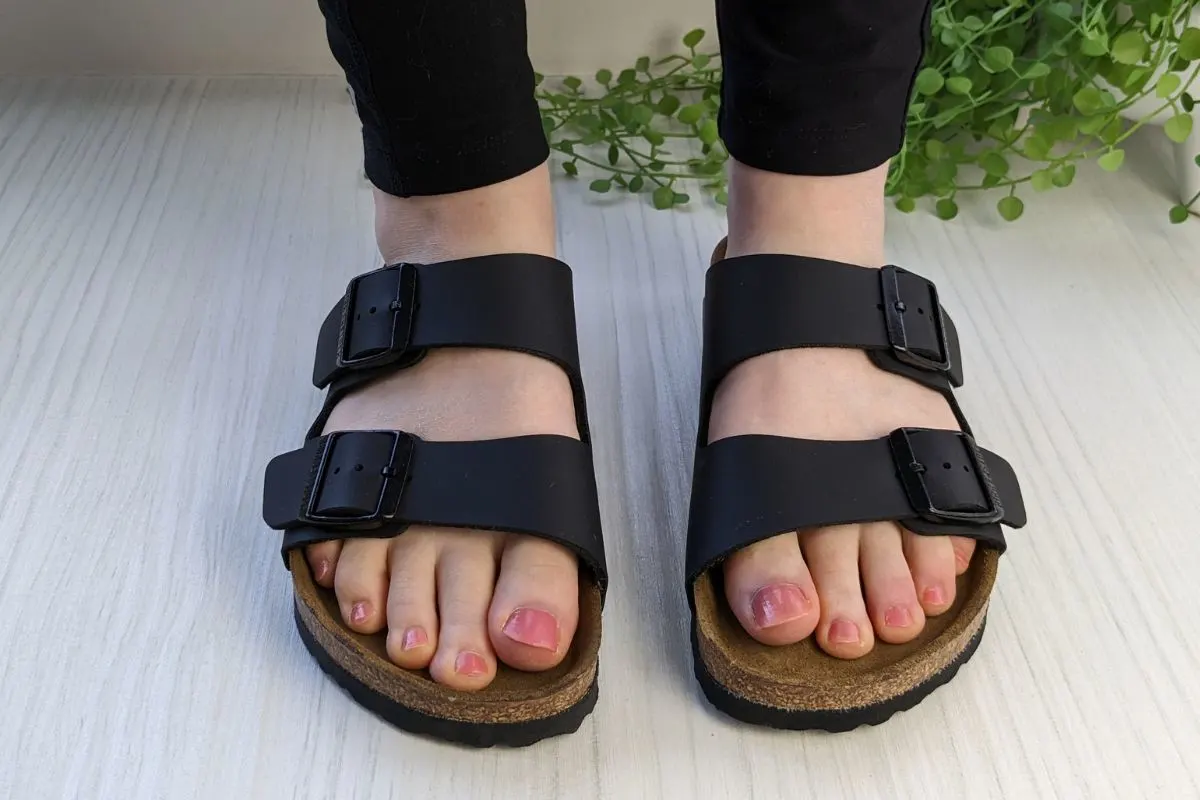
The secret to Birkenstock’s excellent footwear reputation is the orthopedic knowledge passed down from generation to generation. The brand’s heritage lies in the commitment to making and continually improving footwear that enables wearers to walk comfortably and correctly.
What’s great about the company is that foot placement and support are in its DNA, and Birkenstock continues to innovate to improve the orthopedic benefits of its footwear. They are experts in the field and are recognized by Podiatrists as providing effective medical solutions for foot problems, not least of which is flat feet.
Dr. Michelle Campbell, from the Campbell Chiropractic Centre has an excellent video advising the use of Birkenstocks for arch and foot pain. She discusses Birkenstocks at the 1:22 mark, if you’d like to get her take:
A Sandy Footstep Is The Blueprint
An interesting fact is that Birkenstocks are sculpted to resemble a sandy footprint. Flat feet will form a natural arch with sand for support. When you stand with your feet in soft sand, the sand fills all the gaps giving your foot correct balance and proportion. This concept is what makes the Birkenstock mold so ingenious and unique.
Walking action is ideal when you walk on sand. The heel touches the ground first and then rolls through your foot onto the ball, and the toes touch down last. Birkenstock calls this walking the way nature intended, and its shoe designs use this as a starting point.
You may also like: How To Break In Birkenstocks Fast – 10 Ways (My Experience)
Flat Feet Cause A Ripple Effect From The Feet To The Spine
Researching Birkenstocks and their benefits for flat feet cast light on numerous musculoskeletal problems that flat feet cause.
The body’s balance starts at the feet and works its way up from there. Any imbalance in the foot stance causes problems with toes, arches, heels, ankles, Achilles tendons, calves, knees, hips, and spine.
Flat feet are a perfect example of imbalance. The body’s weight must be distributed evenly through the ball of the feet to ensure correct alignment. Stable balance also requires each toe to be firmly planted on the ground.
With flat feet, the balance shifts to the inside of the foot. This affects the standing position, the gait you walk, and the strides you take.
An unbalanced foot can also lead to other painful conditions, such as:
- Leg cramps
- Aches and fatigue in the foot or leg
- Plantar Fasciitis causes stabbing pain in the feet. It’s a condition where the tissue that runs from the heel to the toes (plantar fascia) becomes inflamed, making walking and standing painful.
- Misaligned and deformed toes, such as hammer toes
- Bunions
- Sore knee joints
- Overpronation is where your foot shifts weight inward, causing your knees to turn inwards and affecting your walking.
- Collapsed arches
- Pain in the hips
- Heel spurs are small calcium deposits that attempt to correct and support arches.
- Shin splints are pain caused by inflammation of the shin’s muscles, tissue, and tendons.
- Back pain
Podiatrists Have Their Say On The Matter
Podiatrists advocate for arch and foot support to alleviate the discomforts accompanying flat feet. Birkenstocks provide a tried and tested alternative to traditional footwear.
A scroll through various articles written by podiatrists makes it clear that Birkenstock delivers on all levels of foot health and does the trick for flat feet.
The Birkenstock Footbed Contours, Shapes, And Realigns Feet
The Birkenstock footbed is revolutionary in forming and shaping to create a complete solution for all types of feet, particularly flat feet. Flat feet are one of the most problematic foot conditions as they misalign the entire body’s frame.
The great thing about Birkenstocks is that the entire shoe is designed to realign your foot and plays a significant role in alleviating foot pain and correcting misaligned bones, tendons, and muscles. The Birkenstock design places your feet in the correct position from heel to toe.
Many footwear brands have attempted to mimic the high-performing footbed. Still, none have succeeded in delivering the same benefits as Birkenstocks. Cheap knockoffs on the market will treat your feet differently than Birkenstocks. Ensure you get an authentic Birkenstock shoe to enjoy the benefits and foot comfort.
Birkenstock Molding Work Wonders To Support Flat Feet
Inherent to the design of all Birkenstocks are several foot contours and supports that guide your foot placement:
- The contour down the length of your foot is shaped and raised to prevent arches from falling and keeps the ideal arch height.
- The toe bar positions toes at correct angles to ensure that the body’s weight is evenly distributed across the ball of the foot. It also ensures that your toes are correctly aligned.
- The side supports the feet and prevents rolling onto either side of the foot.
- The heel cup holds heels firmly to prevent strain and pain.
- The raised front and back edges keep your foot correctly positioned without slippage around the shoe.
Birkenstock Footbeds Are Made To Address Orthopedic Problems
Birkenstock footbeds are made from cork, latex, and jute. The benefits of this combination make the footbed shock absorbent to cushion your feet and prevent injury to or sprain on not only your feet but the entire muscle, tendon, and bone structure of your legs.
Jute Is Super Strong
The first layer of a Birkenstock is jute. Jute is made of plant material which is used to create long fibers. These fibers provide a stable base for Birkenstocks and are strong. Jute is typically used for ropes and construction, so it can withstand heavy-duty use. The third layer of Birkenstock’s footbed is also jute. This molds around the footbed and makes the shoe less rigid.
Cork And Latex Absorb Shock
The second layer of the footbed comprises a cork and latex combination, which is proven to stabilize feet and provide shock absorption. Cork has long been considered an ideal base for a footbed, and latex adds flexibility.
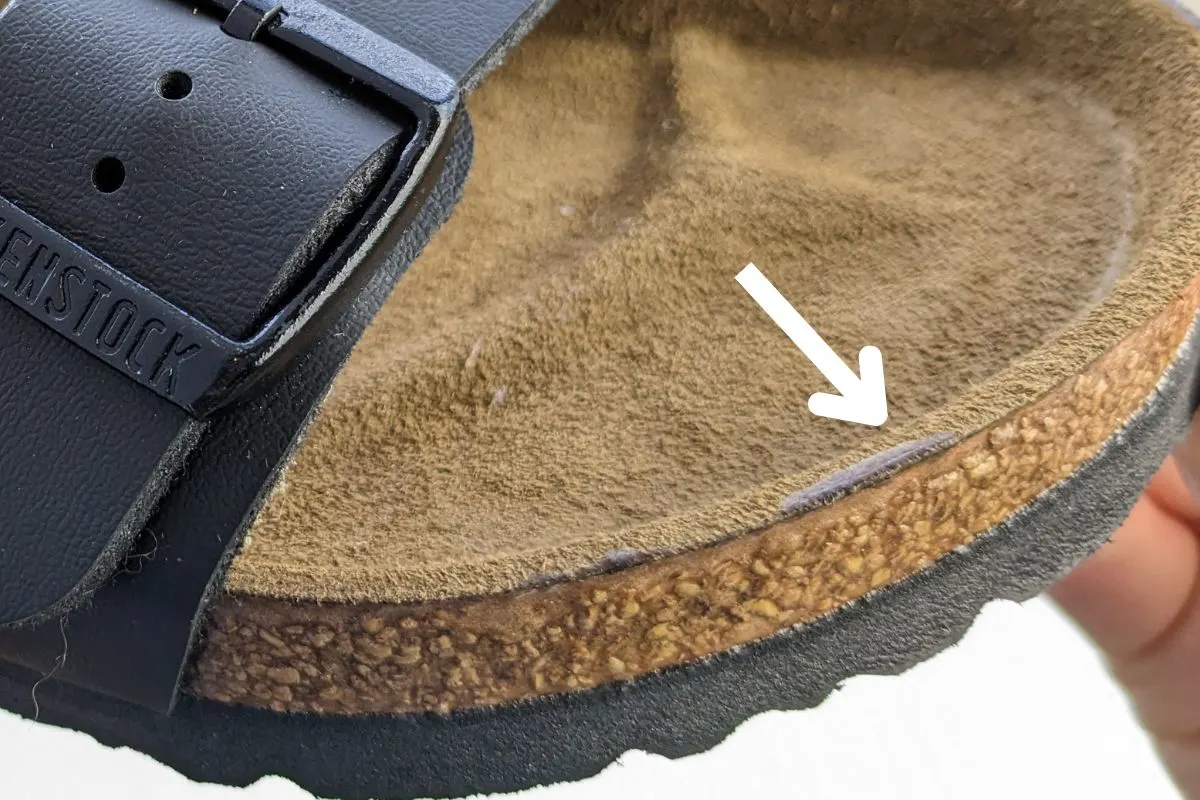
There are many reasons that cork is regarded as an ideal foot base. These benefits are:
- Flexibility so it molds to the shape of your foot
- Cork is stabilizing and improves balance
- Lightweight allowing for easy movement and walking
- Cork is durable
- Moisture absorbent to allow your feet to stay dry
- Odor repellant to keep your feet smelling fresh
The Suede Lining Controls Foot Temperature
The final lining of the footbed is suede which is manufactured to exceptionally high standards specifically for Birkenstock footbeds. Content feet are neither too hot nor too cold. Temperature control in Birkenstocks adds to the advantage of being comfy in your shoes all day long.
There Are Two Types Of Classic Birkenstock Footbed
The regular footbed is the original Birkenstock standard that provides perfect support but takes a while to break in. The soft footbed has a layer of foam between the cork and suede which makes the shoe easier to wear from the get-go.
EVA Is A Welcome Addition To The Footbed Family
Birkenstocks have a third footbed solution which is made from EVA. EVA is ethylene-vinyl acetate which is soft and flexible. It’s crack-resistant and tough.
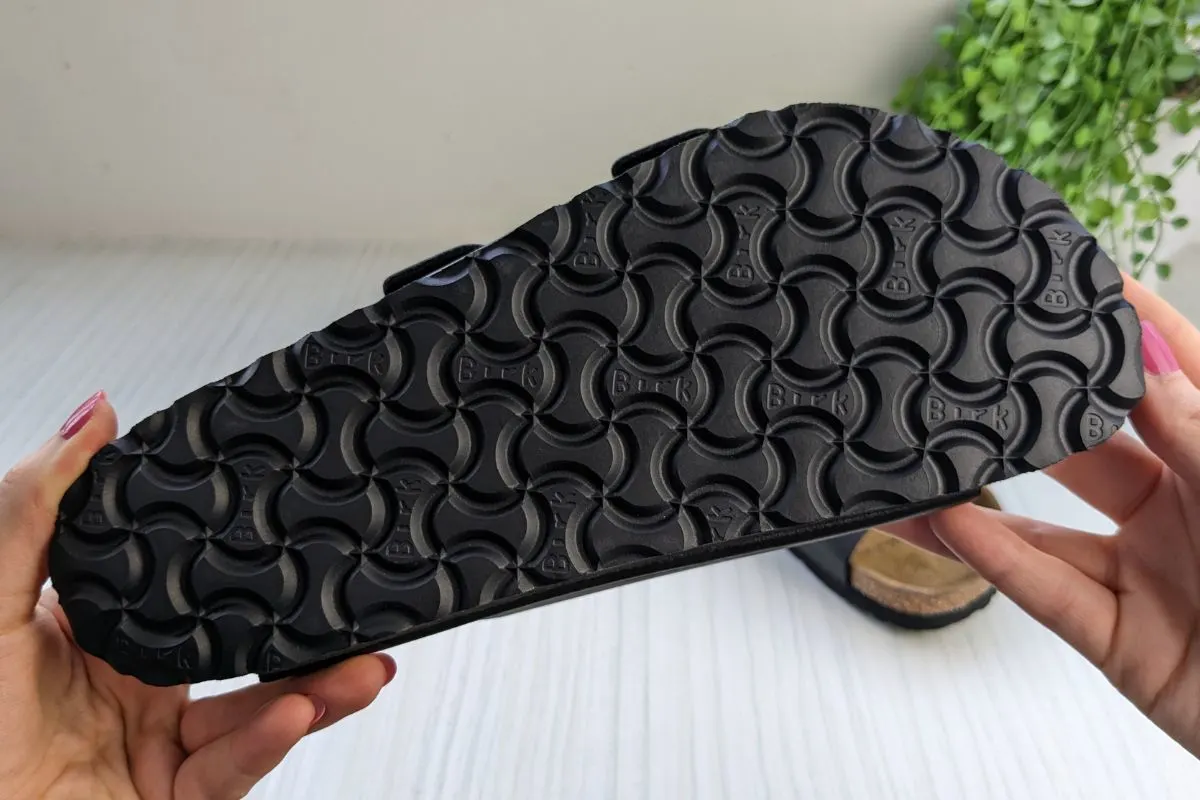
The EVA footbed offers the same contouring as the Classic footbed. However, it is waterproof and ultra-lightweight, making this sole ideal for wearing at the beach or gardening. It’s also easy to clean.
Find Out Whether You are In Fact Flat Footed
Most of us will have a good idea of whether we have flat feet. To be certain, do a quick test.
- Wet your feet so they are sufficiently damp enough to make a wet stamp but not drenched, as this will obscure your true foot shape.
- Place your feet on a piece of cardboard and stand as you would normally, allowing the moisture from your feet to soak into the board.
- Remove your feet and trace around the outline.
A flat foot will have no indentation in the middle of the foot, whereas a normal arch will be much narrower across the center of your foot.
There Are Two Types Of Flat Feet
There isn’t one shape of the flat foot. Flat feet can either be flexible or rigid. To find out which foot you have, look at your feet in a relaxed position, with your feet off the floor.
A flexible foot will appear to have a natural arch in a resting position but will flatten out once it carries your weight. On the other hand, a rigid foot will be flat irrespective of whether your foot is in a neutral position.
Birkenstocks aren’t ideal for rigid feet and will hurt them. Your foot won’t be able to flex around the molded instep. This will cause you more pain than a pair of normal shoes. Your best bet is to visit a podiatrist for advice.
Choose The Correct Size To Get The Maximum Benefit.
You must buy the correct size to get the best health and comfort benefits from your Birkenstocks. If your shoes are too long or too short, too narrow, or too wide, Birkenstocks won’t be able to work their foot magic.
The trick to measuring your foot is to stand on a thick piece of paper or cardboard, spreading your weight as you would in your natural standing position. Trace around your foot to determine the size. Enlist help from a family member or friend; if you bend down to trace the line, part of your foot may lift, and you’ll get the wrong measurements.
To take accurate measurements for your Birkenstock fit, don’t trace tightly around your foot; allow a small amount of breathing space, but not too much. Five millimeters is ideal.
Birkenstocks are designed to give your toes some wriggle room in sandals and closed shoes. A constricted measurement won’t be comfortable at all.
Fortunately, the Birkenstock website has great sizing information. Not only does it detail sizes in length, but it also has a nifty width foot guide. The sizing template is downloadable and fits onto an A4 sheet of paper. I also have my own Birkenstock sizing guide here, full of my own experience and photos: Do Birkenstocks Run Big? Sizing Guide Plus Charts.
There is a length measurement guide that measures length in millimeters. Millimeters provide the most accurate measurement as they are broken down into smaller denominations than inches. To correctly measure the length of your foot, measure from the back part of the heel to your longest toe.
Here are three charts for easy size referencing:
Children’s sizes
| Length in Millimeters | U.S. Size | U.K. Size | European Size |
| 150 | 6 – 6.5 | 7 | 24 |
| 160 | 7 -7.5 | 8 | 25 |
| 165 | 8 – 8.5 | 8.5 | 26 |
| 170 | 9 – 9.5 | 9 | 27 |
| 180 | 10 -10.5 | 10 | 28 |
| 185 | 11 – 11.5 | 11 | 29 |
| 190 | 12 – 12.5 | 11.5 | 30 |
| 200 | 13 – 13.5 | 13 | 31 |
| 205 | 1-1.5 | 13.5 | 32 |
| 210 | 2-2.5 | 1 | 33 |
| 220 | 3-3.5 | 2 | 34 |
Women’s Sizes
| Length in Millimeters | U.S. Size | U.K. Size | European Size |
| 225 | 4 – 4.5 | 2.5 | 35 |
| 230 | 5 – 5.5 | 3.5 | 36 |
| 240 | 6 – 6.5 | 4.5 | 37 |
| 245 | 7 -7.5 | 5.0 | 38 |
| 250 | 8 – 8.5 | 5.5 | 39 |
| 260 | 9 – 9.5 | 7.0 | 40 |
| 265 | 10 – 10.5 | 7.5 | 41 |
| 270 | 11 – 11.5 | 8.0 | 42 |
Men’s Sizes
| Length in Millimeters | U.S. Size | U.K. Size | European Size |
| 260 | 7 – 7.5 | 7.0 | 40 |
| 265 | 8 – 8.5 | 7.5 | 41 |
| 270 | 9 – 9.5 | 8.0 | 42 |
| 280 | 10 – 10.5 | 9.0 | 43 |
| 285 | 11 – 11.5 | 9.5 | 44 |
| 290 | 12 – 12.5 | 10.5 | 45 |
| 300 | 13 – 13.5 | 11.5 | 46 |
| 305 | 14 – 14.5 | 12.0 | 47 |
| 310 | 15 – 15.5 | 13.0 | 48 |
| 320 | 16 – 16.5 | 14.0 | 49 |
| 325 | 17 – 17.5 | 14.5 | 50 |
Width Plays A Role
Once you’ve found your foot length, use the width guide to determine which width of shoe to buy.
Birkenstocks come in narrow and wide fits, and the downloadable diagram has a curved shape foot chart.
Place your right foot on the measurement guide. Draw around the outline of your foot and compare this to the measurement diagram. If your foot falls within the curved line, buy a narrow fit, but if it falls outside the guideline, then go for a regular fit.
A woman’s regular is the American equivalent of C-D, and narrow corresponds with A-B. Men’s shoes in regular width measure up to D-EE and narrow match B-C width.
Put Your Best Foot Forward
Traditionally health-conscious footwear was dowdy and often considered a fashion faux pas. Today things are different, and correcting foot alignment no longer means wearing boring medical shoes.
Birkenstock leads on this front, with many celebrities and designers flaunting theirs.
The footwear descriptions on the Birkenstock website reveal that the entire range is constructed for foot health and aesthetic appeal. The range includes sandals, closed shoes, boots, beach-friendly shoes, and work shoes. Birkenstocks have introduced a Shearling and Zermatt Canvas range specifically for comfort around the home.
There are kids’ styles too. Correct foot placement in early development alleviates foot, ankle, leg, and knee problems later in life.
Frequently Asked Questions
Do Birkenstocks Cure Flat Feet?
No, they don’t. They provide all the necessary support to ensure the wearer’s feet, ankles, shins, leg bones and muscles, and knees align correctly. Wearing your Birkenstocks often alleviates much of the pain that wearing normal shoes would cause.
Do You Need To Break Birkenstocks In?
It takes about 2 weeks to break in your Birkenstocks. Break them in slowly and use your fingers to flex the top part of the shoe to make it less rigid. Even though it may initially be uncomfortable and painful, the benefits of persevering with your Birkenstocks far outweigh any discomfort.
What’s The Difference Between Professional Birkenstocks And The Rest Of The Range?
Birkenstocks and Birkenstock Professional shoes both feature the same molded sole; however, the workwear range caters to professionals in the healthcare and hospitality industries. The Birki range is made from Polyurethane and is easy to clean and disinfect. The Super Grip range provides extra grip to prevent occupational hazards such as falls and injuries.
Will It Take Long To Feel The Benefits Of Wearing Birkenstocks?
After you’ve broken in your Birkenstocks, you will gradually feel that your feet and legs aren’t as tired at the end of the day. You’ll find walking easier, and even if you spend an entire day on your feet, you will notice that the pain your flat arches cause no longer bothers you. Be patient, and don’t discard your Birkenstocks just because they aren’t initially comfortable.
Will My Birkenstocks Lose Their Shape?
They won’t. Birkenstocks are designed to mold your feet and hold your foot’s shape. Each time you wear your shoes, you’ll notice that they feel more and more comfortable.
Conclusion
Birkenstocks were created to correctly position feet so that wearers walk as nature intended. The range is perfect for flat-footed people as it provides adequate arch support to ensure that feet don’t lean inwards. The toe bar aligns toes correctly and allows the body’s weight to spread across the whole ball of the foot, alleviating strain on bones, joints, and muscles.
For more Birkenstocks content, check out:
Are Birkenstocks Comfortable? My Experience (Plus Photos)
Can Birkenstocks Get Wet? Water Test (PHOTOS)

Lorna is a footwear geek and the founder of Wearably Weird. She created a YouTube channel in 2021 for fellow footwear fanatics, dedicated to detail-rich footwear reviews and info. She has a fashion media qualification (awarded in 2011).
